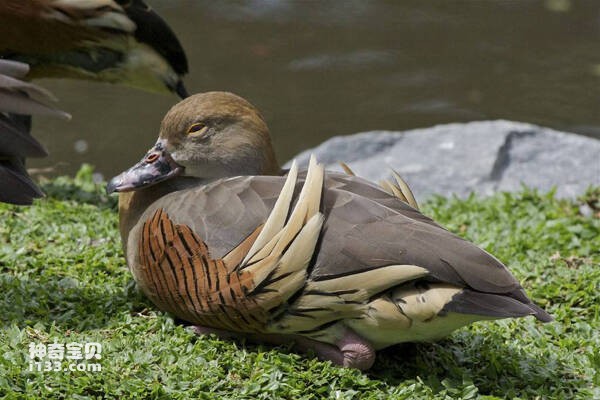Dendrocygna eytoni
IUCN
LCBasic Information
Scientific classification
- name:Dendrocygna eytoni
- Scientific Name:Dendrocygna eytoni,Plumed Whistling Duck,Plumed Whistling-duck,Grass Whistling Duck
- Outline:Waterfowl
- Family:
Vital signs
- length:40-45CM
- Weight:680-900g
- lifetime:No textual research information is available
Feature
There are oval pale yellow and black markings on both sides of the chest and abdomen curved upward, and the anal circumference and subtail are white ice cream color
Distribution and Habitat
It is found in Australia and New Zealand, including Tasmania and its nearby islands.
It is found in swamps, lagoons, lakes, reservoirs, mangroves and other waters, but also in swamps and surrounding ponds and streams covered with plants. They prefer to hide in tall grass or under lotus leaves, and also live in groups on water, but usually avoid open lakes.
Appearance
It is 40-45 cm long and weighs 680-900 g. Both sexes are similar. The top cap, neck and breast of the adult duck are brown, and the head and neck are bluish-gray. The most obvious is the oval pale yellow and black markings on the sides of the chest and abdomen curved upward, and the anal circumference and subtail are white ice cream colors. Underwing coverts light brown. The front part of the wings is olive gray, slightly darker at the back. The tail has dark yellow spots. Rump and tail dark brown. Duck bill is flesh pink with black spots. Legs and feet are pink. Iris light yellow.
Details
Plumed Whistling Duck (Dendrocygna eytoni) : Plumed Whistling duck, Plumed whistling-duck, Grass Whistling Duck, no subspecies.

When the sharp-feathered duck rests, the body is upright, and a few of them often look around from time to time, and take off first when people or enemies are near, followed by other trees and ducks, and their sex is extremely alert. Often in groups of a few to dozens of activities and foraging, there are many to hundreds of large groups. It is weak in flight and not as fast as other ducks. Also good at swimming and diving, and diving ability is very strong, a dive up to ten minutes. During the hot day, they often sleep and rest in the reeds or other tall water weeds. Their habitat changes due to rainy seasons and drought, and they sometimes migrate in groups for short distances to areas with abundant water and food.

The sharp-plumed duck is monogamous and may last a lifetime. The breeding season is in February and March in northern Australia. Southern varieties in September and October. The variation of spawning season is largely dependent on the abundance of precipitation. When the years are dry, spawning can be delayed or only part of the population. A shrub or grass-covered area near water. Courtship and mating take place in the water. Before mating, the male and female ducks swim together. The male ducks continuously dip his beak towards the female, and the female ducks maintain an upright position. Each brood lays 8-14 eggs, generally about 10, and the eggs are white. The eggs are incubated by both sexes for 27-30 days.
Listed on the International Union for Conservation of Nature (IUCN) 2012 Red List of Threatened Species ver 3.1 - Not Threatened (LC).
Protect wild animals and eliminate wild meat.
Maintaining ecological balance is everyone's responsibility!








